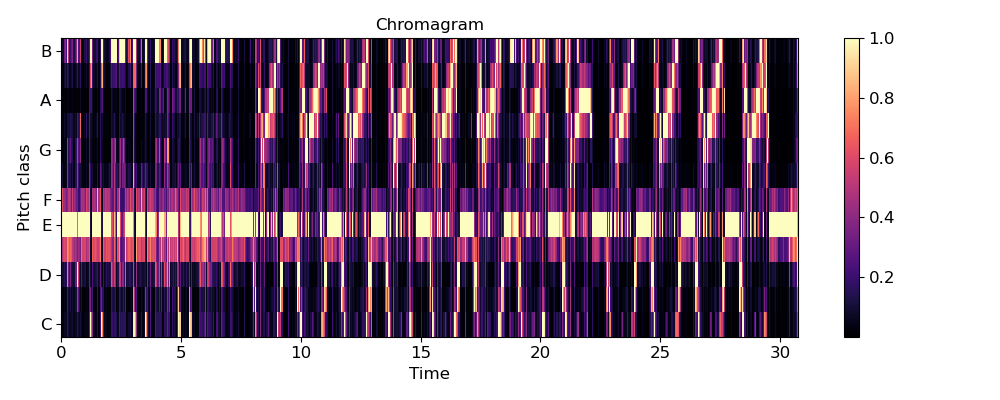Caution
You're reading an old version of this documentation. If you want up-to-date information, please have a look at 0.9.1.
librosa.feature.chroma_stft¶
- librosa.feature.chroma_stft(y=None, sr=22050, S=None, norm=inf, n_fft=2048, hop_length=512, win_length=None, window='hann', center=True, pad_mode='reflect', tuning=None, n_chroma=12, **kwargs)[source]¶
Compute a chromagram from a waveform or power spectrogram.
This implementation is derived from chromagram_E [1]
- 1
Ellis, Daniel P.W. “Chroma feature analysis and synthesis” 2007/04/21 http://labrosa.ee.columbia.edu/matlab/chroma-ansyn/
- Parameters
- ynp.ndarray [shape=(n,)] or None
audio time series
- srnumber > 0 [scalar]
sampling rate of y
- Snp.ndarray [shape=(d, t)] or None
power spectrogram
- normfloat or None
Column-wise normalization. See
librosa.util.normalizefor details.If None, no normalization is performed.
- n_fftint > 0 [scalar]
FFT window size if provided y, sr instead of S
- hop_lengthint > 0 [scalar]
hop length if provided y, sr instead of S
- win_lengthint <= n_fft [scalar]
Each frame of audio is windowed by window(). The window will be of length win_length and then padded with zeros to match n_fft.
If unspecified, defaults to
win_length = n_fft.- windowstring, tuple, number, function, or np.ndarray [shape=(n_fft,)]
a window specification (string, tuple, or number); see
scipy.signal.get_windowa window function, such as
scipy.signal.hanninga vector or array of length n_fft
- centerboolean
If True, the signal y is padded so that frame t is centered at y[t * hop_length].
If False, then frame t begins at y[t * hop_length]
- pad_modestring
If center=True, the padding mode to use at the edges of the signal. By default, STFT uses reflection padding.
- tuningfloat [scalar] or None.
Deviation from A440 tuning in fractional chroma bins. If None, it is automatically estimated.
- n_chromaint > 0 [scalar]
Number of chroma bins to produce (12 by default).
- kwargsadditional keyword arguments
Arguments to parameterize chroma filters. See
librosa.filters.chromafor details.
- Returns
- chromagramnp.ndarray [shape=(n_chroma, t)]
Normalized energy for each chroma bin at each frame.
See also
librosa.filters.chromaChroma filter bank construction
librosa.util.normalizeVector normalization
Examples
>>> y, sr = librosa.load(librosa.util.example_audio_file()) >>> librosa.feature.chroma_stft(y=y, sr=sr) array([[ 0.974, 0.881, ..., 0.925, 1. ], [ 1. , 0.841, ..., 0.882, 0.878], ..., [ 0.658, 0.985, ..., 0.878, 0.764], [ 0.969, 0.92 , ..., 0.974, 0.915]])
Use an energy (magnitude) spectrum instead of power spectrogram
>>> S = np.abs(librosa.stft(y)) >>> chroma = librosa.feature.chroma_stft(S=S, sr=sr) >>> chroma array([[ 0.884, 0.91 , ..., 0.861, 0.858], [ 0.963, 0.785, ..., 0.968, 0.896], ..., [ 0.871, 1. , ..., 0.928, 0.829], [ 1. , 0.982, ..., 0.93 , 0.878]])
Use a pre-computed power spectrogram with a larger frame
>>> S = np.abs(librosa.stft(y, n_fft=4096))**2 >>> chroma = librosa.feature.chroma_stft(S=S, sr=sr) >>> chroma array([[ 0.685, 0.477, ..., 0.961, 0.986], [ 0.674, 0.452, ..., 0.952, 0.926], ..., [ 0.844, 0.575, ..., 0.934, 0.869], [ 0.793, 0.663, ..., 0.964, 0.972]])
>>> import matplotlib.pyplot as plt >>> plt.figure(figsize=(10, 4)) >>> librosa.display.specshow(chroma, y_axis='chroma', x_axis='time') >>> plt.colorbar() >>> plt.title('Chromagram') >>> plt.tight_layout() >>> plt.show()
